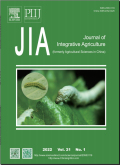首页|期刊导航|农业科学学报(英文)|General and specialized metabolites in peanut roots regulate arbuscular mycorrhizal symbiosis
农业科学学报(英文)2024,Vol.43Issue(8):2618-2632,15.DOI:10.1016/j.jia.2023.09.011
General and specialized metabolites in peanut roots regulate arbuscular mycorrhizal symbiosis
General and specialized metabolites in peanut roots regulate arbuscular mycorrhizal symbiosis
摘要
关键词
Arachis hypogaea L./arbuscular mycorrhizae fungi/metabolites/symbiotic associationKey words
Arachis hypogaea L./arbuscular mycorrhizae fungi/metabolites/symbiotic association引用本文复制引用
Li Cui,Yakov Kuzyakov,Shubo Wan,Jianguo Wang,Zhaohui Tang,Zheng Zhang,Sha Yang,Feng Guo,Xinguo Li,Jingjing Meng,Jialei Zhang..General and specialized metabolites in peanut roots regulate arbuscular mycorrhizal symbiosis[J].农业科学学报(英文),2024,43(8):2618-2632,15.基金项目
This work was supported by the National Key R&D Program of China(2022YFD1000105),the Key R&D Program of Shandong Province,China(2021CXGC010804),the Taishan Scholars Project,China(202211275),the Youth Found of Shandong Natural Science Foundation,China(ZR2021QC163),the Natural Science Foundation of Shandong Province,China(ZR2020MC094),the Strategic Academic Leadership Program"Priority 2030"of the Kazan Federal University,Russia,the RUDN University Strategic Academic Leadership Program,China,and the 2022 High-level Talent Innovation and Entrepreneurship(Platform)Project of Linyi,China. (2022YFD1000105)

